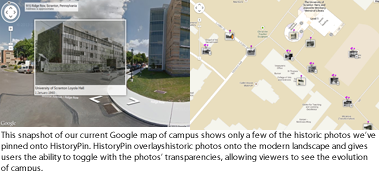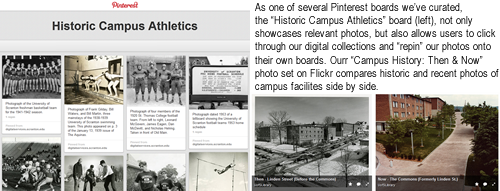Information Update - Fall 2013
University History Shared on Social Media
- As a student, I thought little about the University’s history prior to working in the Library. It was not until I had spent a few summer weeks in the basement of the Library, sorting through
 old, dusty scrapbooks containing decades of old newspaper clippings, that I realized our University history was a story that deserved more attention, and I really wanted to share what I had found. Many historic items were already available online, through the Library’s digital collections. As a work study student in the Library’s Digital Services department, part of my job is to help promote the Library’s digital collections. Social media is one platform we use to share stories from the University’s history. Sites such as Flickr, Pinterest, and HistoryPin present many of these historic photos and documents in a way that is easily accessible to anyone and from anywhere.
old, dusty scrapbooks containing decades of old newspaper clippings, that I realized our University history was a story that deserved more attention, and I really wanted to share what I had found. Many historic items were already available online, through the Library’s digital collections. As a work study student in the Library’s Digital Services department, part of my job is to help promote the Library’s digital collections. Social media is one platform we use to share stories from the University’s history. Sites such as Flickr, Pinterest, and HistoryPin present many of these historic photos and documents in a way that is easily accessible to anyone and from anywhere. - Using Flickr, I compiled a “Campus History: Then & Now” photo set, which showcased buildings and features that had been, or still are, a part of our campus. I was also inspired by other users’ photos on Flickr and tried to recreate their “then and now” photos, in which they matched an old photo onto the current scenery. Through our “From the Archives” mystery photo sets, users are invited to name unidentified students featured in historic photographs.

- On Pinterest, I created several Pinterest boards where I grouped items from our Digital Collections into sets categorized by theme, such as “Presidents of the University of Scranton,” “Historic Campus Athletics,” and “University of Scranton WWII Era Highlights.” The pinned images are linked to the Digital Collections page, where users can click through to find more items. tems on Pinterest are often repinned, encouraging the spread of our archived materials.
 HistoryPin was a new social media tool that I used to promote Digital Collections images. HistoryPin is a fusion of Pinterest and Google Maps, where users “pin” historic photos to Google Maps and are able to digitally superimpose those photos onto the modern landscape through Google Street View. Google Street View makes it easy to visualize where an older facility once stood by allowing users to fade the historic photographs in and out of the modern view. I used HistoryPin to create “tours,” which are historic pictorial narratives that enable users to literally walk through time. Currently, tours of the Commons, Gunster Memorial Student Center, the Weinberg Memorial Library, as well as tours by era, are available.
HistoryPin was a new social media tool that I used to promote Digital Collections images. HistoryPin is a fusion of Pinterest and Google Maps, where users “pin” historic photos to Google Maps and are able to digitally superimpose those photos onto the modern landscape through Google Street View. Google Street View makes it easy to visualize where an older facility once stood by allowing users to fade the historic photographs in and out of the modern view. I used HistoryPin to create “tours,” which are historic pictorial narratives that enable users to literally walk through time. Currently, tours of the Commons, Gunster Memorial Student Center, the Weinberg Memorial Library, as well as tours by era, are available.- Working with the Digital Collections images in social media has also led me to consider working with them in another way. My experience with our University’s history, combined with my interest in World War II, has become a springboard for a possible honors project. The end of that particular story is not yet clear, but the end of my original story that began in the basement of the library, where I had been digging through decaying scrapbooks, concludes with an invitation for you to see what I have shared.
—April Francia ’15 is a work study student
in the Library’s Digital Services department
| Univeristy Social Media Sites |
||
| Flickr: flickr.com/universityofscrantonlibrary/ | ||
| Pinterest: pinterest.com/uofslibrary/ | ||
| HistoryPin: historypin.com/channels/view/7195265 | ||
| Digital Collections: scranton.edu/library/digitalcollections |

